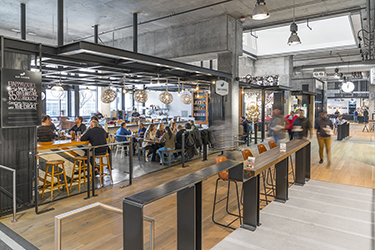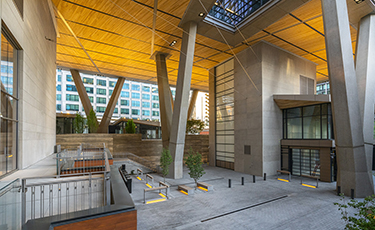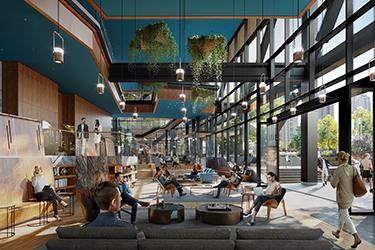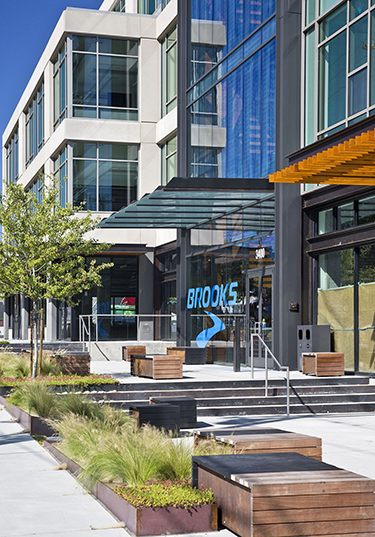|
Subscribe / Renew |
|
|
Contact Us |
|
| ► Subscribe to our Free Weekly Newsletter | |
| home | Welcome, sign in or click here to subscribe. | login |
Real Estate
| |
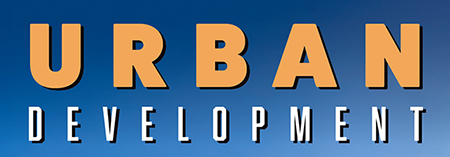 |
May 27, 2021
Diverse spaces are key to returning urban cores to normal
Skanska USA Commercial Development
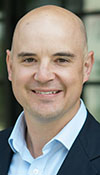
Foushee
|
For more than a year, we have seen plenty of news stories questioning whether there is still a need for office space. The line separating work from home has blurred and COVID-19 has only catapulted that trend. While commute times certainly have improved, many aspects of work-life balance have not.
But just like Mark Twain, who is often quoted as saying “the reports of my death have been greatly exaggerated,” so, too, is the purported demise of the downtown core.
In fact, I believe that it will be good urban development — and specifically a well-thought and engaging ground plane and public space — that will help restore the vibrancy of downtowns and bring back workers, neighbors and tourists.
Truth be told, there is no perfect place to work. While many things can be done from the office or from home, neither is ideal for every type of work. More and more potential tenants we talk with have voiced the need for a diverse set of workspaces within the buildings they lease. For them, it’s about offering their employees amenities and space to connect, collaborate and spur creative ideas.
This diversity of environment has become a hallmark of our work and has led to spaces like the Urban Village, Tenant Lounge and 19th floor deck at 2+U, the Market Hall at 400 Fairview, and the Living Room and Plaza we’ll soon be building at The Eight in Bellevue. What’s more, these spaces are important not only to tenants, but also to the surrounding community and overall urban fabric of our cities. We regularly see people from the neighborhoods surrounding the buildings come into these public spaces to eat, shop, work and engage with one another, something that is not possible in a traditional office lobby that requires keycard access to even enter the building.
Humans, by nature, are social animals, which means we need spaces — now more than ever — where we can be together and that give us a reason to come together again. It’s one thing to walk into a traditional building and head up to the office, but we find the idea of transitions and merging different uses together inherently more interesting, both from design and community use perspectives. Easy access to a mix of retail, dining and arts are all important for bringing communities together, which is an essential component to having a thriving urban core.
That means we as developers need to create destinations and experiences worth returning to. While we want people to enjoy our spaces because of their unique designs, we’re also very proud of our work to create welcoming spaces for all — that blend into the culture and fabric of the immediate surroundings.
In our view, a big part of urban development is finding a connection between the city, the neighborhood and the tenants. That’s a sweet spot Skanska strives for with every project we undertake.
At 400 Fairview, that took the form of the covered back deck, Market Hall, and arguably the most diverse shopping and dining experience in any single location in the city. At 2+U, the ground plane features the Urban Village that hosts local favorites such as Caffe Ladro, Valiant Barber & Supply, Tavolata, Porter, an amazing arts experience managed by Shunpike and the Downtown Seattle Association. At Stone 34, that meant bringing to life the local community’s vision of a seamless transition to the nearby Burke-Gilman Trail. And at our forthcoming development of The Eight, we’re focused on building a connection to nature — a mini “park within the city” — and spacious and flexible collaboration spaces like the Living Room and the Plaza.
As our cities grow, another factor that more and more tenants ask about is the environmental footprint of and sustainability plan for a building. For example, Stone 34 was the first Living Building Pilot building in Seattle, and I’m proud of the fact that every office building Skanska has developed in the Puget Sound region has been at least LEED gold certified. In fact, 2+U recently received LEED platinum status, achieving all of the Optimize Energy Performance credits, a meaningful step towards Skanska’s corporate goal to be net zero by 2045.
Of course, given current public health circumstances, the importance of healthy spaces cannot be understated. That does not mean antiseptic and sterile spaces, but rather a combination of evolving technologies that we can implement to our buildings. For example, systems that allow us to bring more fresh outside air indoors, better filtration systems in buildings, and the integration of touchless technology, but also things like easy access to outdoor spaces and natural daylight. The health of those who use our buildings is too important not to have these factors at the forefront when planning our developments and knowing that developers are doing so gives people the confidence that they’re retuning to a safe space.
When so many people have been forced out of their normal routines and forced out of daily life in our downtown cores, we need a reason to come back. We need spaces where everyone is welcome, not just the keycard carriers. We need to be less insular, to be a community again, and to be more open to engaging with each other and our surroundings in new and different ways. At Skanska, we plan to be a part of building that future, and after a year away from the office, it’s one we’re very excited about.
Charlie Foushee is vice president of development at Skanska USA Commercial Development.
Other Stories:
- Coming soon: A surge of TODs in the Bel-Red corridor
- The many shades of green
- Regional growth: Towns, small cities should choose to lead or be led
- Our city, our time
- Sustainable urban design: connecting community and nature
- Placemaking in pocket parks: Sustaining authenticity in growing urban neighborhoods
- Little houses everywhere: How ADUs will reshape the urban fabric
- Coming soon: A surge of TODs in the Bel-Red corridor
- Making changes that last generations
- Preparing for Bellevue’s dynamic future
- Infinity Shore Club shows resilience of Seattle market
- Meeting the SE 2050 Challenge



